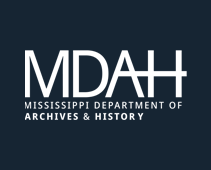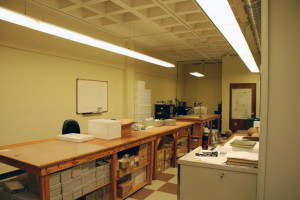MDAH first began collecting artifacts for display in the State Historical Museum in 1902. These collections consisted of artifacts which had been donated to or purchased by MDAH. Since the 1930s, artifacts from archeological excavations conducted by the Mississippi Archaeological Survey, as well as those from private donors, have been curated here. In 2004, the Charlotte Capers building became the current repository for the archaeological collections curated at MDAH. This facility once served as the MDAH Archives and Library building and was designed for archiving the state’s records and collections (Figure 1).
Currently, the MDAH Archaeological Repository holds all records and materials associated with multiple research projects conducted by the MDAH archaeological staff and contractors. The repository meets Federal curation standards and has the capacity to accept additional collections. At present time, collections are held under formal agreement with the U. S. Forest Service (USFS), the Mississippi Department of Transportation (MDOT), and the Natural Resource Conservation Service (NRCS). Collections are also held for a number of private entities, most of which have federal sourcing.
Facilities
The MDAH Archaeological Repository was designed specifically for curating and conserving the state’s records and collections. Built for security with climate controlled conditions including thick concrete exterior walls and poured concrete floors, it is virtually fireproof. The location of the facility is on the third floor of the Charlotte Capers Building (Capers) and houses all the archaeological collections. With seven miles of movable shelving, the facility is capable of storing over 20,000 curation boxes measuring 15 X 12 X 10. The area is environmentally controlled by a heating-ventilating-air-conditioning system designed to maintain temperatures at 68 to 70 degrees Fahrenheit year-round (Figure 2).
In addition to the repository on the third floor, there is an archaeological laboratory where collections may be cleaned, conserved, and prepared for long-term curation. This area is also environmentally controlled and contains a laboratory chemical fume hood in addition to three large commercial sinks (Figure 3).
Standards for Collection
Artifact Collections
All artifacts are required to be cleaned, sorted by provenience, and properly labeled before being processed at the repository. Artifacts and collections which are not in proper condition are either refused for curation or properly processed at the repository for a fee. Artifacts are required to be in 4 mil polypropylene zip-lock bags with a white label marked with proper provenience by permanent marker. An artifact inventory list must accompany all artifact collections that are to be curated at MDAH.
Artifact collections are re-inventoried and re-boxed into the standard curation box ((15”x12”x10”) 3mm, inert, corrugated polypropylene or Coroplast ® storage boxes) unless they are already boxed in an equivalent curation box. Label information must include the company name, project, site number (if applicable), box number, provenience and contents.
Artifact boxes are stored two to a shelf side by side on enameled metal shelves 32 inches long, 13 inches wide, and 12 inches high. They are organized by row, bay, and shelf number. Original inventory sheets are kept on cotton bonded paper and filed in the archaeological laboratory. Two copies of these inventory sheets are made and filed separately, with one copy accompanying the collection and one on file in the collection manager’s office.
Records Collection
All records and notes must be accompanied by a catalog. The catalog must include but is not limited to: project, site, record type, and subject for each document or group of related documents. All field notes, forms, drawings, catalogues, and inventories must be printed or copied onto acid-free paper. All paper records must be placed in acid-free archival folders that are permanently labeled with the pertinent information listed above. No metal paperclips, staples or any other metal material attachments are permitted in record storage. A copy of all records must be submitted on acid-free paper. These will be stored separately from the originals as per 36 CFR Part 79.9, 6ii.
All computer generated media must be accompanied by a paper copy of the data contained on the cd, flash drive, etc. and must include a description of the programs used to create the data. If any information was derived by custom computer programming, a description of the file structures must also be included. All metadata must also be included. All records will be re-boxed into standard MDAH curation boxed and stored on enameled metal shelves 32 inches long, 13 inches wide, and 12 inches high. These records are organized by row, bay, and shelf number and stored two boxes to a shelf side by side.
All archaeological records are re-inventoried at the repository and a copy of this record inventory sheet is curated with the record box. Original repository record inventory sheets are on cotton bonded paper and are filed in the Collection Manager’s office.
Maps and Oversized Documents
MDAH has metal flat files making it possible to store maps and other oversized documents. The cabinets are 53 ½ inches wide, 40 ½ inches long, and 3 inches high. The cabinets are lined with acid-free buffered map folder stock and sets of documents are contained within envelopes made from the same stock. Documents stored in these cabinets will have all pertinent information associated with them inventoried and a copy will be curated with the maps/oversized documents. An inventory similar to but separate from the page sized records is maintained for oversized documents.
Photographic Materials
Black and white film must be processed to archival standard (see National Park Service Standards for photographs). All negatives must be stored in 8 ½ x 11” polyethylene pages. Archival quality folders, pages, or envelopes must be used for other photographic materials which will not fit into a standard page size holder. These items are then filed by project/site in archival files in plastic non-acidic boxes on shelves in the curation facility. A copy of the original photo log is duplicated on cotton bonded archival paper to accompany the photographs.
Re:Discovery Database System
All collections and associated records are accessioned into the MDAH Re:Discovery Database System. This system is similar to the ANCS+ database that the National Park Service currently uses. Accessioning collections into this system provides a systematic and controlled environment for yearly inventory, random inventory, queries, and research. We are currently working on the web module that will allow our collections inventories to be viewed on line allowing ease of access to researchers and Native American Tribes. One of our main priorities is to encourage research on curated collections. Please note, however, that although we curate federal collections, and encourage study of these collections, it is our policy that researchers must have written permission and approval from the federal agency in control of the collection before access to these collections is granted and any research is allowed.


